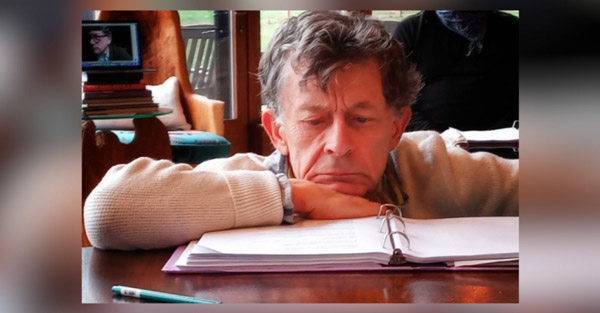By Ilene Dube, JerseyArts.com
originally published: 06/20/2024
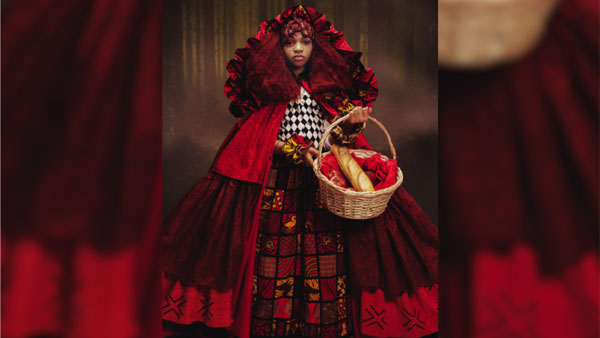
If you’re looking for the Folk Life Center of New Jersey, don’t type it into Google Maps, don’t go looking for a physical facility; rather, the Folk Life Center is an umbrella for activities, workshops, and exhibitions, says Sharon Kiefer, curator of exhibitions at the Perkins Center for the Arts, who has collaborated with the Folk Life Center for Perkins’ current exhibition.
There is actually a network of five folklife centers throughout the state that operate in partnership with the New Jersey State Council on the Arts. Since 2016, the Perkins Center has presented mandala makers, folk musicians, African American hair braiders, duck decoy makers, and community cooks and bakers in celebration of the South Jersey region’s heritage and traditions.
The Folklife Center is part of Perkins’ work to support and sustain locally produced art in all forms, according to its website. “Unlike most art forms created for aesthetic and entertainment purposes, folklore brings us the magic of intergenerational, ancestral, and present-day connections… The joy of our work is putting these special artists front and center and setting the stage for them to show up and have people say, ‘Hey, I see myself in what’s happening here.’ The power of folklore is the power of human connection.”
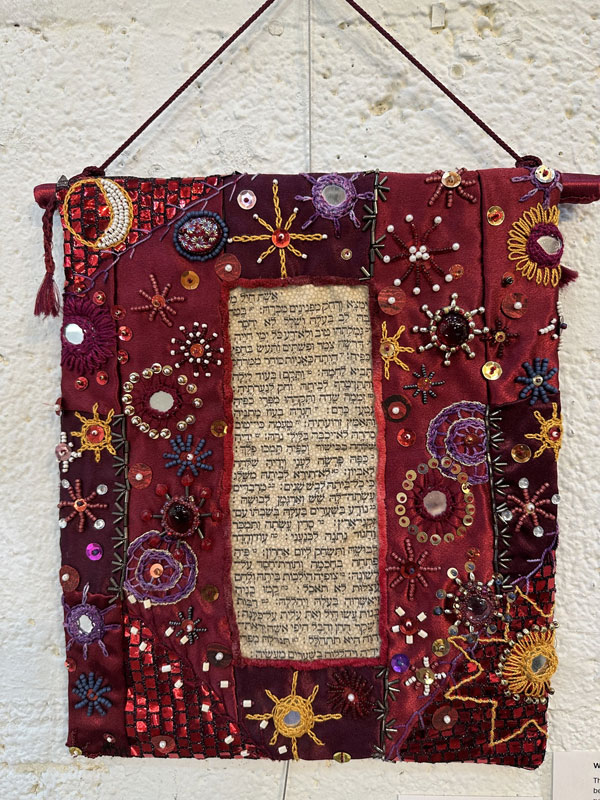
Spector, Arlene Diane. Woman of Valor. Photo by Ilene Dube
In collaboration with the Down Jersey Folk Life Center at WheatonArts, the Perkins Center is presenting Threaded: Contemporary Expressions of Traditional Fiber Arts, on view at its Collingswood Main Gallery through June 28. Viewers can see how artists use traditional techniques such as weaving, embroidery, quilting, basketry, and crocheting to create contemporary expressions.
“Fiber arts represent a beautiful array of techniques that transform plant, animal, and synthetic fibers, resulting in yarns, fabrics, and baskets,” says Amanda Hamill, assistant to the curator, in an audio tour available in the gallery. “The manipulation of fibers for both utilitarian and decorative purposes have played a vital role in the history of human civilization. It is a means of cultural expression, storytelling, survival, status, and celebration. Heartfelt traditions have formed around these techniques generation after generation.”
Upon entering the gallery, viewers encounter life-size mannequins dressed in regal gowns made from African textiles. The first is “The Metropolitan Opera Coat 1883,” by artist Sara Bunn. Statuesque and elegant, the coat with Persian lamb peplum and cuffs and bronze silk rosette trim, is composed of individual squares with photo-transfer portraits of beautiful Black women. Each is ornamented with jewels, lace, hand painting, and hand stitching. The outfit is accessorized with a feather-plumed hat and a satchel also made of portrait squares.
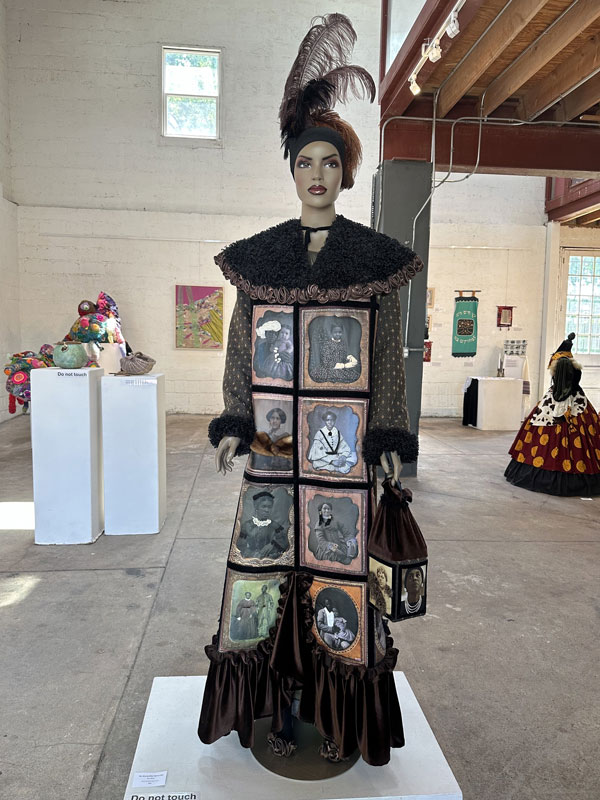
Bunn, Sara. The Metropolitan Opera Coat 1883. Photo by Ilene Dube
On the back of the coat, framed in bronze arabesques, is a legend to explain it: The 20 panels represent 19th-century African-American women, symbolizing those barred from the Metropolitan Opera House. “It would be 1955 before Marian Anderson would perform,” writes Bunn, listing the names of those who followed Anderson, from Leontyne Price, Kathleen Battle, and others to “the youngest operatic voice of color today, Victory Brinker,” cited in the Guinness Book of World Records as the world's youngest opera singer.
“The foremost purpose of this piece was to symbolically bring the Ancestors, once shunned, through the doors of the Opera House with dignity,” Bunn writes in an artist statement. The garment made its debut exhibition in the home of the late Faith Ringgold, artist, author, storyteller, and quilter. “Designed to honor women devoted to the art of quilting, and to the seamstresses of my world, the coat pays homage to my grandmothers and their grandmothers,” continues Bunn, a self-described fabric griot.
There are several other works by Bunn, including “Red: Red Riding Hood of the Diaspora.” “Red’s ensemble was constructed using remnants of Ankara, an ethnographic textile beloved for its colorful motifs,” writes Bunn in the framed legend on the back of the garment. Ankara cotton textiles, also known as African wax prints, are popular in contemporary West Africa and originated from ancient batik methods from Indonesia.
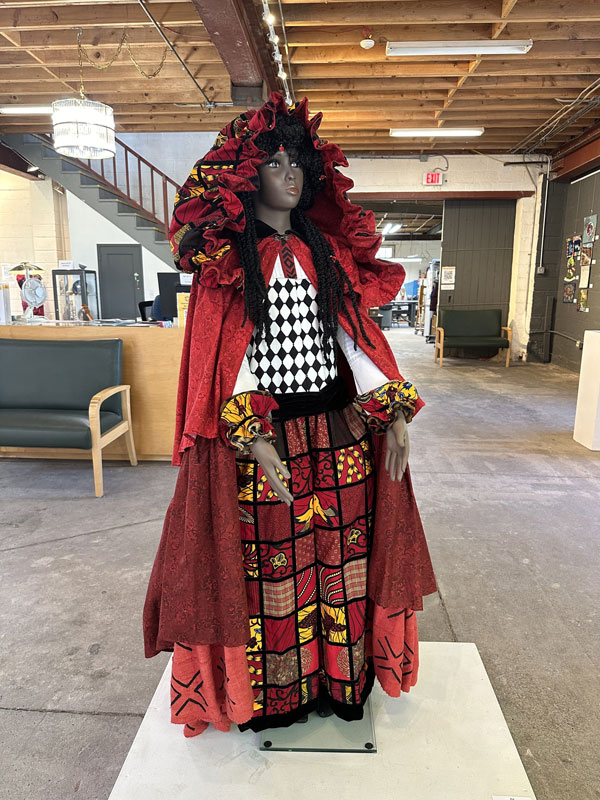
Bunn, Sara. Red Riding Hood of the Diaspora. Photo by Ilene Dube
There are many tiers and layers intricately stitched together employing such techniques as “fussy cutting,” hand-printed African mud cloth, and geometric block printing. “During these times of rising inclusivity and representation, this Riding Hood heroine has her ancestral origins in Africa,” says Bunn, and “her garb reflects her heritage.”
“Rani” – queen in Swahili – is based on the “wedding of the decade” – that of Meghan Markle to Prince Harry. “Little brown girls all over the world saw themselves reflected in the new Duchess of Sussex,” writes Bunn. “Rani” is made up of the artist’s grandmother’s vintage silk and velvet scarf of embroidered paisley, trimmed with hand beading. Lace and trimming remnants from vintage curtains became the lower portion of her sleeves.
If the name of the artist Asiyah Kurtz sounds familiar, it’s because Kurtz heads the Camden Fireworks Gallery. Here, the applied anthropologist and fiber artist is represented by her quilts that upcycle materials such as denim. “I want to juxtapose the intersections of cotton and chattel slavery with the history of my birthplace (Memphis, Tennessee),” says Kurtz. For her quilt “Pick a Bale O’ Cotton,” she writes “I included an old photo of my Uncle Amos Williams as he bales cotton with his co-worker and quilted lyrics from the eponymous song by Fannie Lou Hamer.”
From Kurtz’s roots, which trace back to Sierra Leone, Africa, we move along to traditional Jewish ceremonial cloths by Arlene Diane Specter. A needlepoint “The Fig” is named for the seeded fruit that symbolizes “the promise and blessing of Israel as well as peace and prosperity,” says the artist, who employs polished gems, beads, and shisha mirrors that derive from 17th-century Indian embroidery techniques. Fradele Feld has created torah and challah covers.
Wafa Ayyad has created “Narrative of Palestinian Culture and Heritage” and “Tribute to My Grandmothers” using tatreez, a Palestinian embroidery technique like cross-stitch. Tatreez is a centuries-old art form preserved and orally transmitted to the next generation. Ayyad teaches tatreez at arts centers, and even taught in the encampment during the Rutgers protests in spring. A third-generation practitioner of tatreez, she talks about the symbolism behind the patterns and the ways in which embroidery has been used to preserve memories and express cultural identity.
“The Palestinian tatreez design showcases a rich array of geometric motifs, featuring intricate depictions of trees, branches, plants, feathers, flowers, and birds,” says the artist. “Stars are prominent, symbolizing the enduring spirit of generosity among the Palestinian people. Each motif serves as a heartfelt tribute to the land and its resilient inhabitants, weaving together a narrative of cultural heritage and collective identity.”
Marcie Ziskind works in wet felting. Her “Little Village Pots” look like a miniature of Rapunzel’s tower. “Woodland Crown” was made in honor of Ziskind’s 98-year-old mother, “a strong, resilient, progressive woman, who is still my steadfast support and biggest fan.”
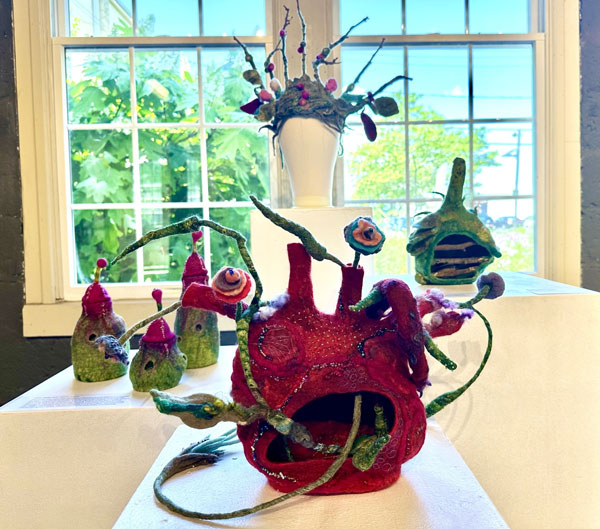
Ziskind, Marcie. The Hole in my Heart is Blooming and other works. Photo by Ilene Dube
“What started as a hobby has turned into my passion,” she says. “I have learned that blessings in life can be transformational. With water and soap, wool is altered, and it all comes out in the wash. When fibers are refashioned, unique beauty is created.”
At center is a red organ with colorful tendrils sprouting from it. “Years after my oldest son’s death,” she writes, “I feel as if the hole In my heart is blooming. Felting has provided an unexpected outlet for my grief due to the physical and meditative aspects of this craft.”
In addition to the many individual artists, Birds on a Thread Quilt Group contributed their collective quilt squares, made from such upcycled materials as fabric from other projects, plastic bags, recycled clothing, jeans, metal and other found materials, antique ribbons and lace, tea bags and labels, paper, and embellishments.
Birds on a Thread, formed in 2013, is made up of artists, teachers, curators, social workers, administrative assistants, and employment counselors. Brought together by a shared passion for quilting, the group and the exhibition exemplify the power of folk arts to heal the world.
Perkins Center for the Arts, Collingswood, NJ | Through June 28th, 2024
About the author: Driven by her love of the arts, and how it can make us better human beings, Ilene Dube has written for JerseyArts, Hyperallergic, WHYY Philadelphia, Sculpture Magazine, Princeton Magazine, U.S. 1, Huffington Post, the Princeton Packet, and many others. She has produced short documentaries on the arts of central New Jersey, as well as segments for State of the Arts, and has curated exhibitions at the Trenton City Museum at Ellarslie and Morven Museum in Princeton, among others. Her own artwork has garnered awards in regional exhibitions and her short stories have appeared in dozens of literary journals. A life-long practitioner of plant-based eating, she can be found stocking up on fresh veggies at the West Windsor Farmers Market.
Content provided by
Discover Jersey Arts, a project of the ArtPride New Jersey Foundation and New Jersey State Council on the Arts.
FEATURED EVENTS
Narrow results by date, categories, or region of New Jersey.
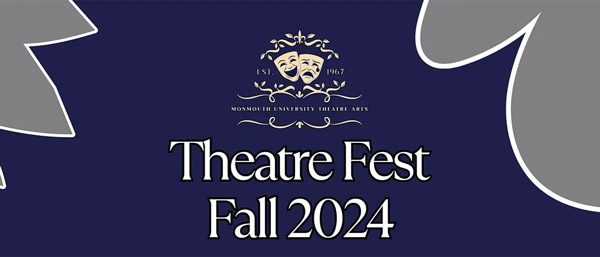
Theatre Fest Fall 2024 – Spark Sessions: A Night of Original Works by MU Players
Thursday, November 21, 2024 @ 8:00pm
Monmouth University - Lauren K. Woods Theatre
370 Cedar Avenue, West Long Branch, NJ 07764
category: theatre
View event page for full information
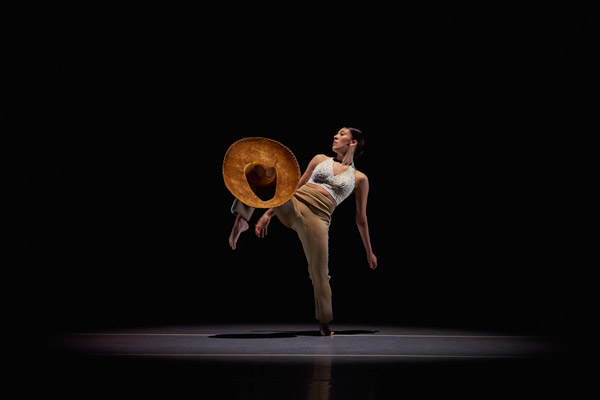
Fall Dance Plus
Thursday, November 21, 2024 @ 7:30pm
New Brunswick Performing Arts Center (NBPAC)
11 Livingston Avenue, New Brunswick, NJ 08901
category: dance
View event page for full information

Elf The Musical
Thursday, November 21, 2024 @ 7:00pm
Count Basie Center for the Arts
99 Monmouth Street, Red Bank, NJ 07701
category: theatre
View event page for full information

World Cinema Series - "Court"
Thursday, November 21, 2024 @ 6:00pm
Monmouth University - Pollak Theatre
400 Cedar Avenue, West Long Branch, NJ 07764
category: film
View event page for full information

Trombone Shorty & Orleans Avenue
Thursday, November 21, 2024 @ 7:30pm
State Theatre New Jersey
15 Livingston Avenue, New Brunswick, NJ 08901
category: music
View event page for full information

Randall Goosby Returns: Renaissance Quartet
Thursday, November 21, 2024 @ 7:30pm
McCarter Theatre Center (Matthews Theater)
91 University Place, Princeton, NJ 08540
category: music
View event page for full information

Marshall Crenshaw - Up Close & Personal
Thursday, November 21, 2024 @ 7:30pm
Lizzie Rose Music Room
217 E. Main Street, Tuckerton, NJ 08087
category: music
View event page for full information
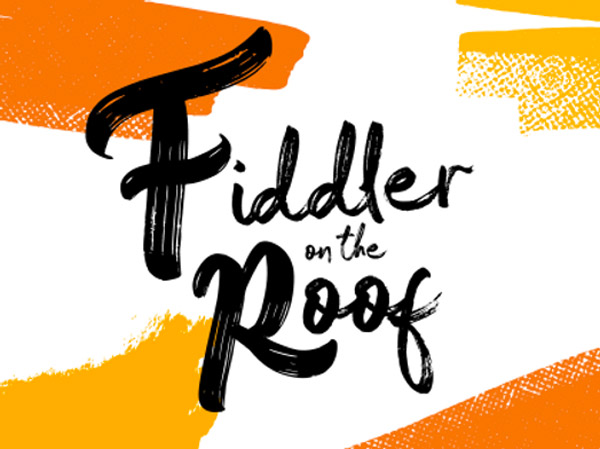
Fiddler On The Roof
Thursday, November 21, 2024 @ 11:00am
Axelrod Performing Arts Center
100 Grant Avenue, Deal Park, NJ 07723
category: theatre
View event page for full information

Steve Hofstetter
Thursday, November 21, 2024 @ 8:00pm
Avenel Performing Arts Center
150 Avenel Street, Avenel, NJ 07001
category: comedy
View event page for full information
More events
Event Listings are available for $10 and included with our banner ad packages
EVENT PREVIEWS

Renaissance Quartet Brings Bold Innovation and Classical Mastery to McCarter Theatre on Thursday
(PRINCETON, NJ) -- Prepare to be captivated by the Renaissance Quartet, featuring violinists Randall Goosby and Jeremiah Blacklow, violist Jameel Martin, and cellist Daniel Hass. Graduates of the Juilliard School and mentored by the legendary Itzhak Perlman, the Quartet brings a unique blend of classical mastery and innovative flair to McCarter Theatre on Thursday, November 21, 2024 at 7:30pm. Known for reimagining chamber music traditions, this New York based ensemble combines technical excellence with a bold, forward-thinking approach that appeals to a diverse audience.
UPCOMING EVENTS
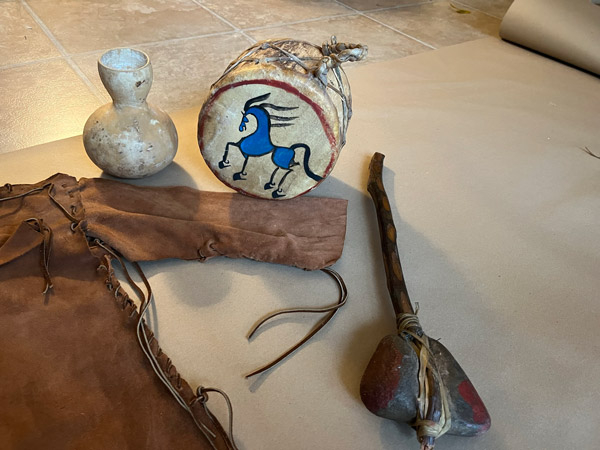
South Jersey's Indigenous Communities Celebrated in New A.C. Arts Garage Exhibit
(ATLANTIC CITY, NJ) -- A new exhibit at the Noyes Arts Garage of Stockton University will celebrate two southern New Jersey tribal communities through the display of historical documents, traditional artifacts and contemporary art. "Still Here: The Nanticoke Lenni-Lenape and Powhatan-Renape Nations of Southern New Jersey" opens October 9 and runs until January 5, 2025.


















